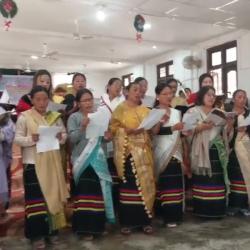A decade back, when in my mid-teens, I went on a trip to Kameng in neighbouring Arunachal Pradesh. I knew that my generation had been very successfully indoctrinated with the concept of Indian and India. So I was looking out for an old grandpa to know the unadulterated reality of erstwhile N.E.F.A (North East Frontier Agency). My wish was answered when I met a gaonburha (village headman), with his grandchild near a hanging rope bridge. I struck a conversation with the tiny tot and his grandpa. When I asked the gaonburha whether he thought himself to be an Indian or a Chinese, I got the most amusing answer I have ever come across till date. The grand old man said, “Xeitutu moi naejanu” (I don’t know that).
In the present day grand Indian socio-political and economic scenario, the gaonburhas are like microbes. They are there, but their existence cannot be seen nor felt. The local politicians and ministers are the jelly fish. They are there, they can be seen, but spineless, without a backbone to support themselves. The central ministers and the massive corporations and giant companies are the whales and sharks, ready to gobble up the numerous microbes and quite a many jelly fish any moment, any time. No doubt, mega dams is imminent in north-east. The pitiable ignorance of the microbes, the lack of assertion of the jelly fish and the disturbingly high ethno-diversity will contribute to the realization of mega dams by the whales and sharks of India. Their best prey being Arunachal Pradesh, followed by Assam.
During the British reign in India, the East India Company acted as the representive of the British Crown. Post 1947, the desi governments act as the representative of the corporate. Mega dams are symbols of greed, more than need. How do we substantiate the generation of more than 70,000 MW when the required stands at 400 MW? The British used the Assam for extraction of fuel (petroleum, coal) and tea production. The scheme continues till date. Nehru made use of Assam (the Assam of the 1940s) for immigration and settlement of refugees from East Bengal. Indira Gandhi continued with the same scheme in the 1970s during the Indo-Pak war 1971. Now Assam and Arunachal Pradesh will be used mega dams. The question is who decides for our resources? Pre-1947, it was the British. Now it is the power lobbies who call the shots from Delhi and their glitzy offices in the commercial capital cities of India. The ground reality has not changed after the British left India. What happened in 15 August, 1947 is more of a shift of power. This can be called ‘Transfer of Power’ Day (T.O.P. Day). It was on this day that the political decision making powers was transferred by the Whites to the Browns (or lets say the ‘Coloured’ to sound politically correct).
The numerous militant groups will defy the Independence Day. But even day can join in to celebrate the event as T.O.P. Day, since they are giving dictats from the ‘Top’. They might also enjoy the ‘transfer of power’ once they get ministerial posts, be it in the present political boundaries or those envisioned by the C-in-Cs. Going by the mode of operation, the percolation of message is from the bosses rather than the echo of the grassroots. While the leaders build fortunes in foreign countries and indulge in all delights, it is the village youths and their families who end their precious lives chasing the elusive mirages created by their respective bosses.
As for me, the next time I visit Kameng, the gaonburha and his village will be long gone. There will be a huge lake instead. The tiny tot might be in some urban pocket. And if I ever come across him, we shall be talking in Hindi. Some persons have decided everything for us. The resentment and aspirations of millions, the pride of existence of the grassroot populace hardly matter for this set of policy makers. Indeed, 15 August carries the essence of ‘T.O.P. Day’.
- Add new comment
- 47201 reads










Comments
Pages
Add new comment